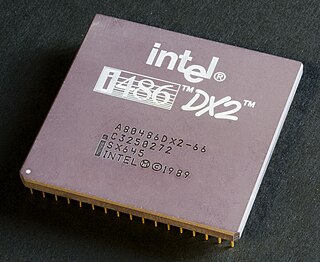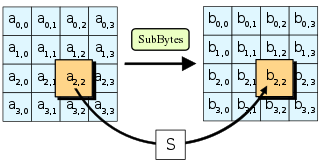RDRAND (previously known as Bull Mountain [1] ) is an instruction for returning random numbers from an Intel on-chip hardware random number generator which has been seeded by an on-chip entropy source. [2] RDRAND is available in Ivy Bridge processors [lower-alpha 1] and is part of the Intel 64 and IA-32 instruction set architectures. AMD added support for the instruction in June 2015. [4]

Intel Corporation is an American multinational corporation and technology company headquartered in Santa Clara, California, in the Silicon Valley. It is the world's second largest and second highest valued semiconductor chip manufacturer based on revenue after being overtaken by Samsung Electronics, and is the inventor of the x86 series of microprocessors, the processors found in most personal computers (PCs). Intel ranked No. 46 in the 2018 Fortune 500 list of the largest United States corporations by total revenue. Intel is incorporated in Delaware.

In computing, a hardware random number generator (HRNG) or true random number generator (TRNG) is a device that generates random numbers from a physical process, rather than by means of an algorithm. Such devices are often based on microscopic phenomena that generate low-level, statistically random "noise" signals, such as thermal noise, the photoelectric effect, involving a beam splitter, and other quantum phenomena. These stochastic processes are, in theory, completely unpredictable, and the theory's assertions of unpredictability are subject to experimental test. This is in contrast to the paradigm of pseudo-random number generation commonly implemented in computer programs.

Ivy Bridge is the codename for the "third generation" of the Intel Core processors. Ivy Bridge is a die shrink to 22 nanometer manufacturing process based on the 32 nanometer Sandy Bridge - see tick–tock model. The name is also applied more broadly to the 22 nm die shrink of the Sandy Bridge microarchitecture based on FinFET ("3D") Tri-Gate transistors, which is also used in the Xeon and Core i7 Ivy Bridge-EX (Ivytown), Ivy Bridge-EP and Ivy Bridge-E microprocessors released in 2013.
Contents
The random number generator is compliant with security and cryptographic standards such as NIST SP 800-90A, [5] FIPS 140-2, and ANSI X9.82. [2] Intel also requested Cryptography Research Inc. to review the random number generator in 2012, which resulted in the paper Analysis of Intel's Ivy Bridge Digital Random Number Generator. [6]
NIST SP 800-90A is a publication by the National Institute of Standards and Technology with the title Recommendation for Random Number Generation Using Deterministic Random Bit Generators. The publication contains the specification for three allegedly cryptographically secure pseudorandom number generators for use in cryptography: Hash_DRBG, HMAC_DRBG, and CTR_DRBG.
The Federal Information Processing Standard (FIPS) Publication 140-2,, is a U.S. government computer security standard used to approve cryptographic modules. The title is Security Requirements for Cryptographic Modules. Initial publication was on May 25, 2001 and was last updated December 3, 2002.
RDSEED is similar to RDRAND and provides higher level access to the entropy hardware. The RDSEED generator and processor instruction rdseed are available with Intel Broadwell CPUs [7] and AMD Zen CPUs. [8]

Broadwell is Intel's codename for the 14 nanometer die shrink of its Haswell microarchitecture. It is a "tick" in Intel's tick–tock principle as the next step in semiconductor fabrication. Like some of the previous tick-tock iterations, Broadwell did not completely replace the full range of CPUs from the previous microarchitecture (Haswell), as there were no low-end desktop CPUs based on Broadwell.

Zen is the codename for a computer processor microarchitecture from AMD, and was first used with their Ryzen series of CPUs in February 2017. The first Zen-based preview system was demonstrated at E3 2016, and first substantially detailed at an event hosted a block away from the Intel Developer Forum 2016. The first Zen-based CPUs codenamed "Summit Ridge" reached the market in early March 2017, Zen-derived Epyc server processors launched in June 2017 and Zen-based APUs arrived in November 2017.



